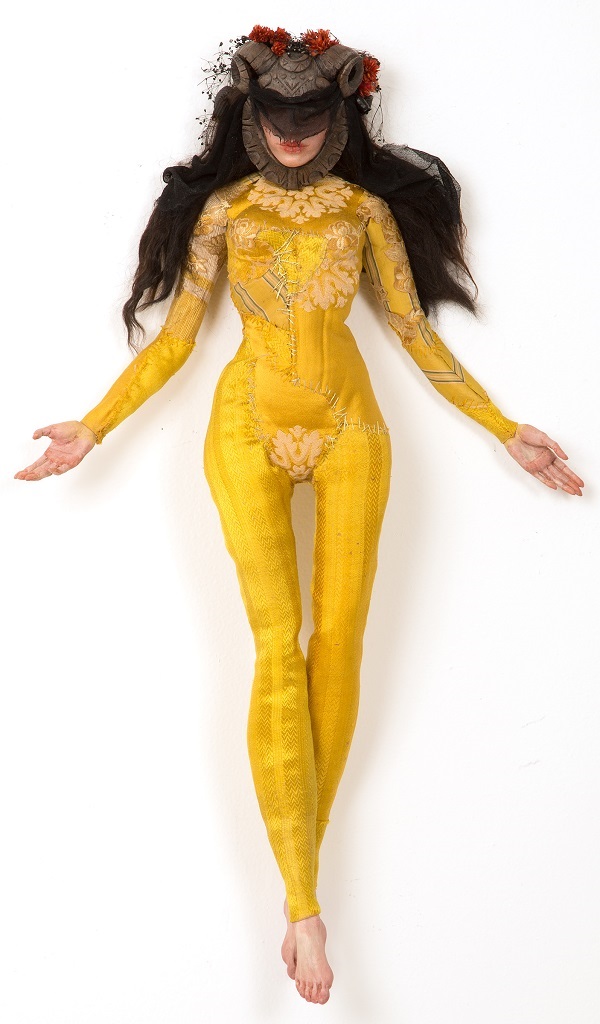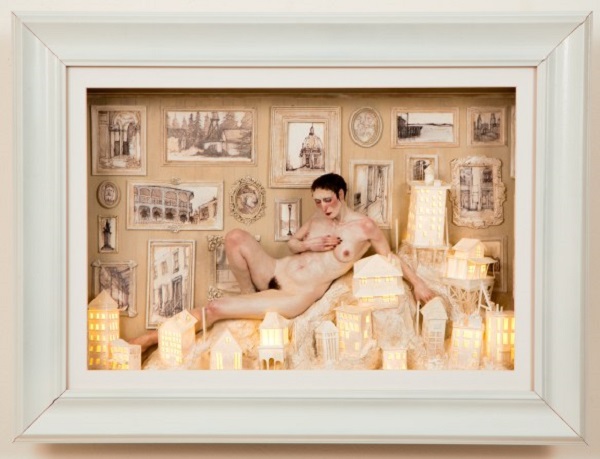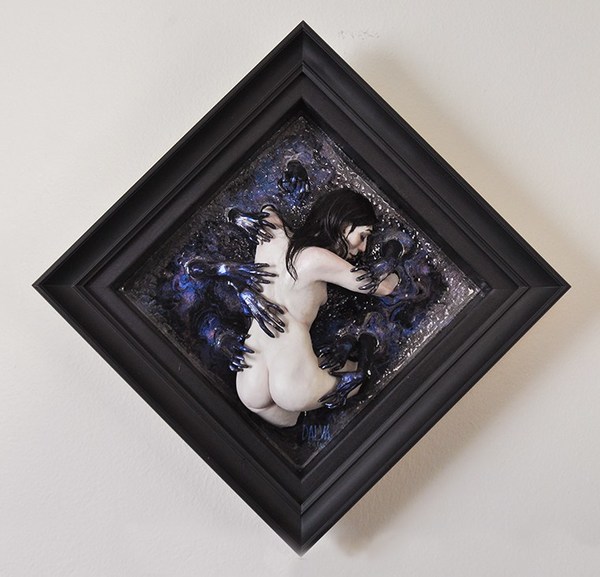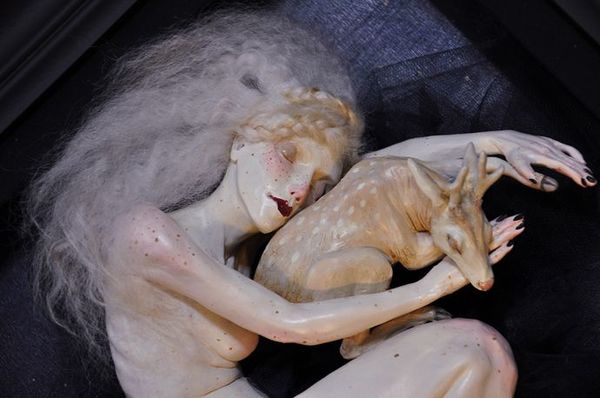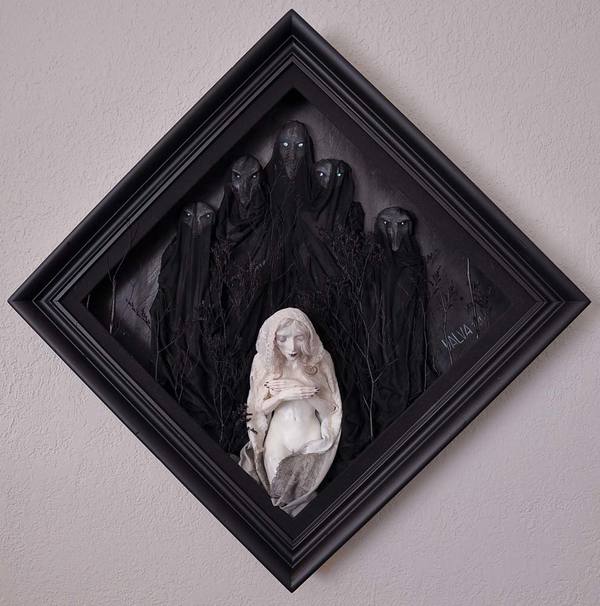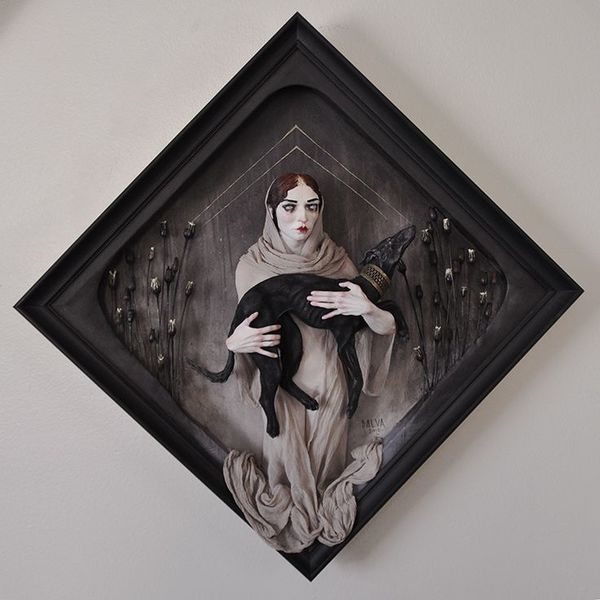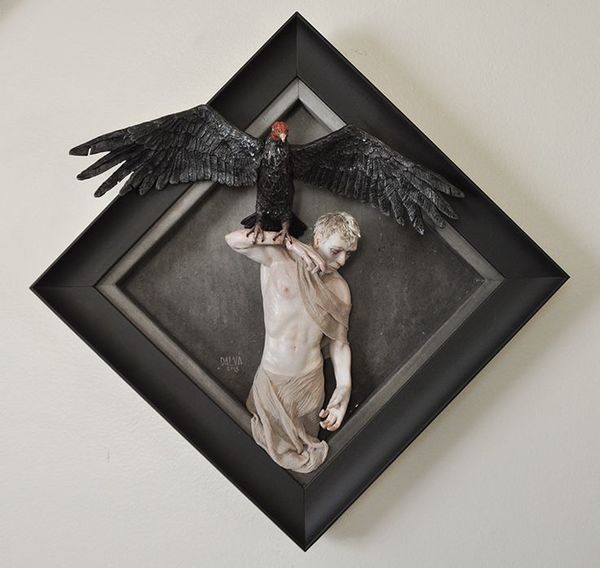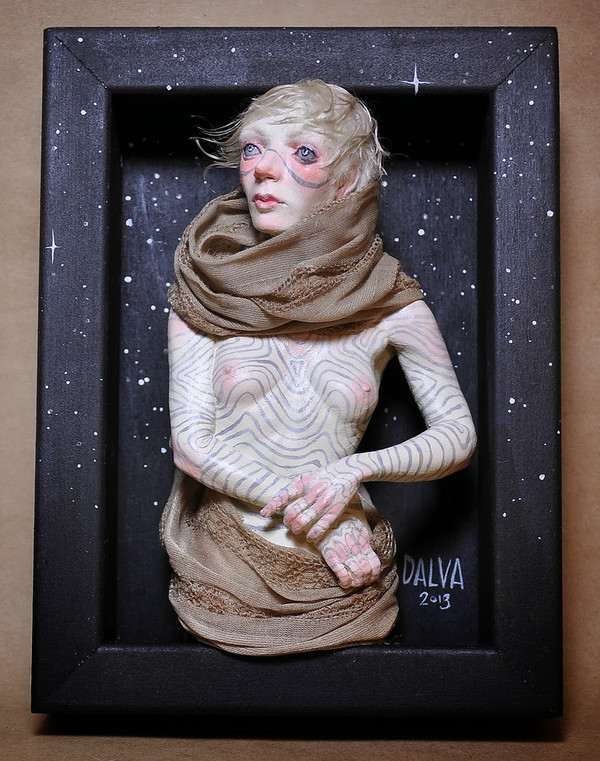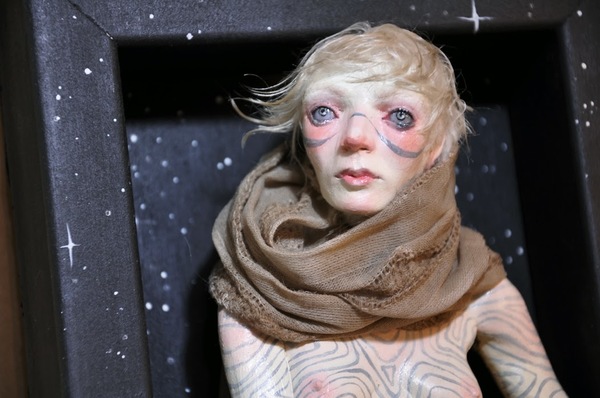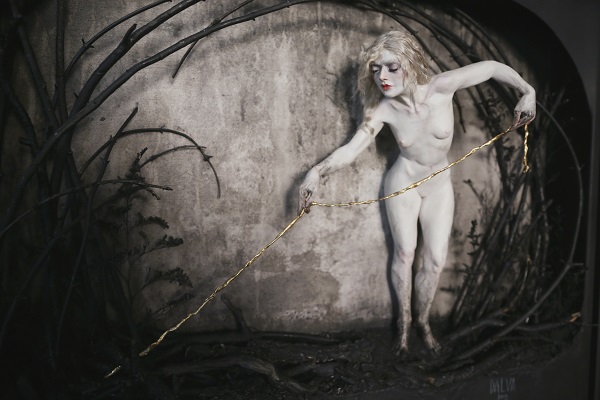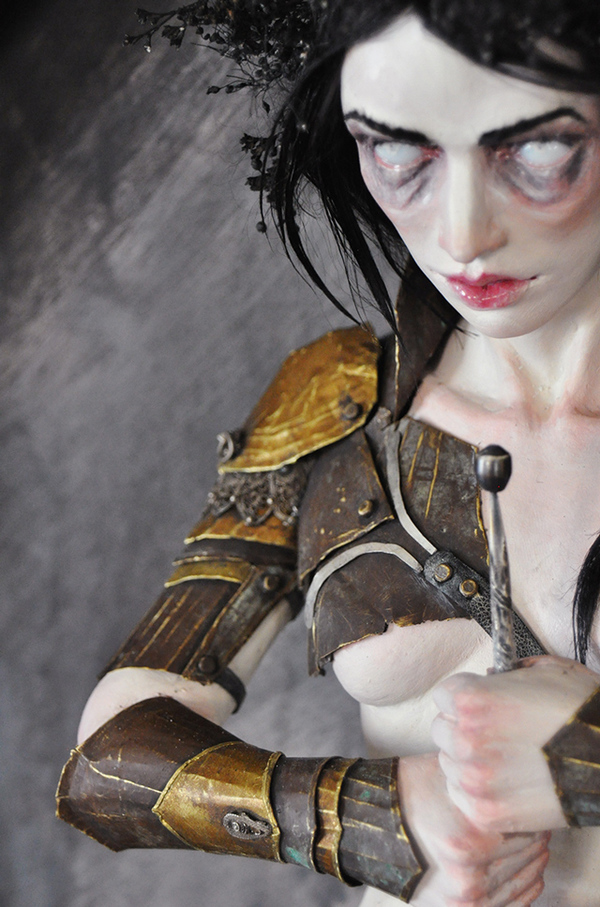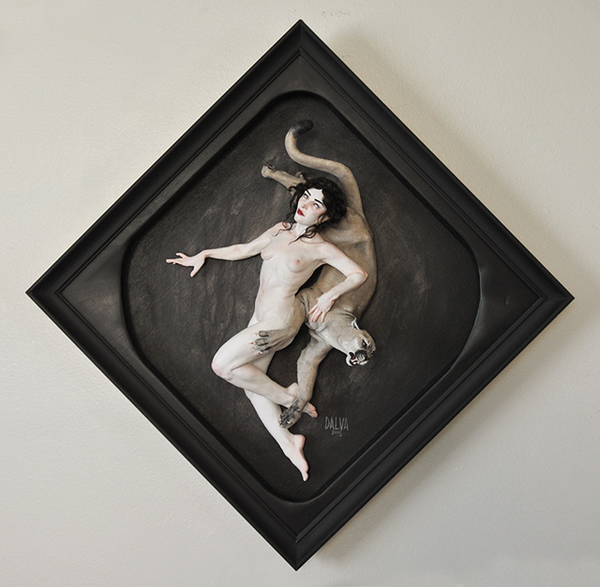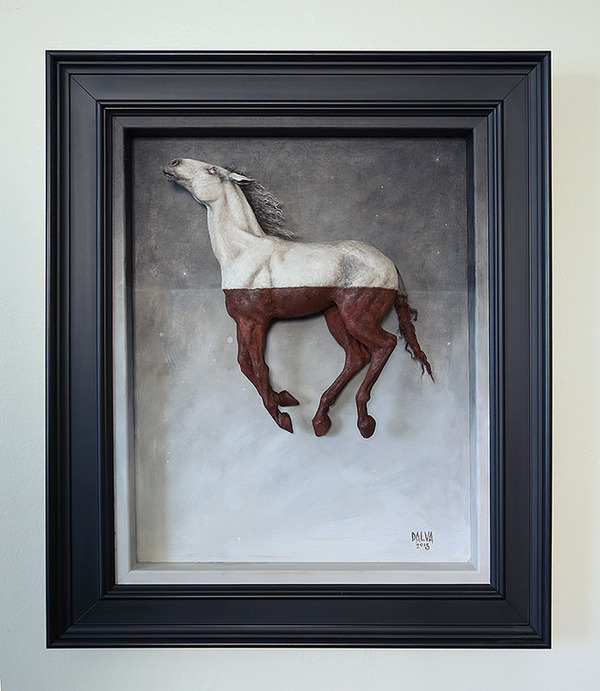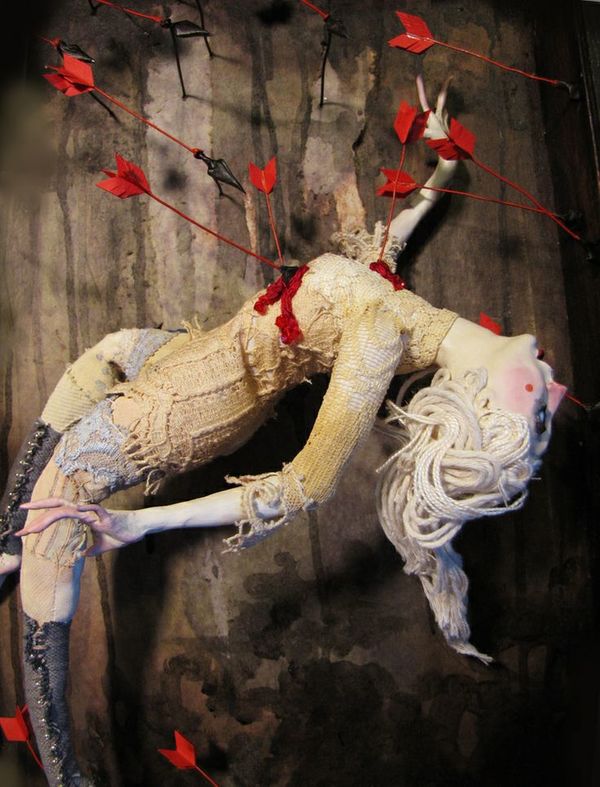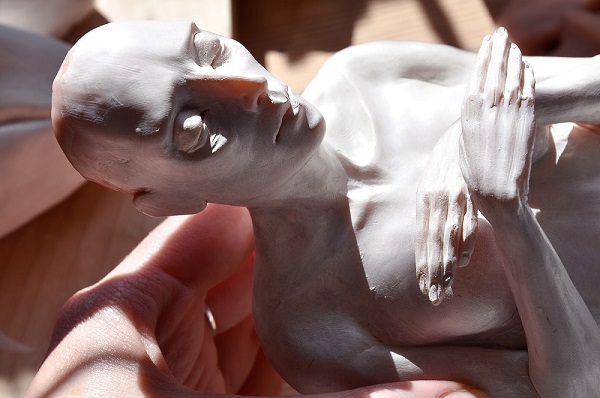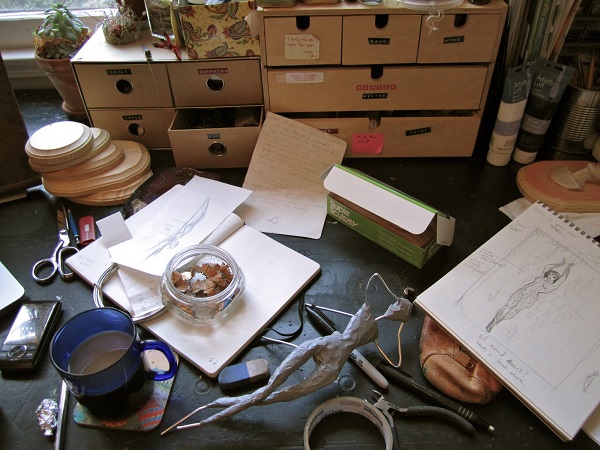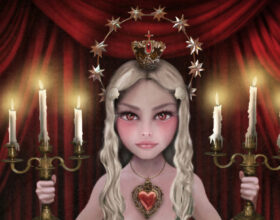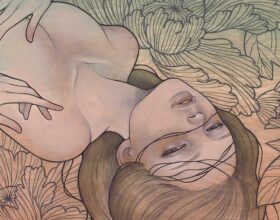“Will someone please call a surgeon
Who can crack my ribs and repair this broken heart
That you’re deserting for better company?”
– lyric from “Nothing Better” by The Postal Service
Jessica Dalva, AKA Jessica Laurel Louise Dalva, is a profoundly capable sculptor and painter that communicates loss, loneliness, and a need for connecting within a context of pale, mystic figures adorned with flowing fabrics, wire, and real hair that moves (ever so gently) in response to the wind. Dalva, who is also a puppet maker, illustrator, and designer, earned a BFA in 2009 from Otis College of Art and Design in Los Angeles and currently lives and works in the San Francisco bay area of California. For the last nine years, she has worked for numerous unique and interesting industries and theater companies as a fabricator, puppet designer, set designer, and model builder. Equally as interesting, she currently maintains and repairs the lifelike wax figures at Madame Tussauds Wax Museum in San Francisco.

Jessica’s newest series of sculptures, titled DREAM HOUSE, showed this spring at Arch Enemy Arts in Philadelphia and featured thirteen works showcasing more fabric work, more freestanding sculptures, and more color than her previous pieces. Additionally, this series truly showcased her mastery of conceptualizing and creating costumes and distressing and treating fabrics so that they display in interesting and believable ways. Dalva is adept at building completely believable gestural expressions that blend realism with distorted or exaggerated details (such as women with elongated fingers, or a perfectly crafted, realistic red horse with stretched, Dali-esque legs) and the time and devotion she’s put into her work has advanced her to (in Star Wars terms) Jedi status. It is here that she finds peace (rather than frustration) in constructing the intricacies of her work. “A lot of these pieces were therapeutic,” Dalva said of DREAM HOUSE, “(as I find much of art making in general) not only in resolving thoughts for myself but in that, in order for the idea to be realized, many processes had to be repeated over and over. These steps, such as cutting out and gluing together hundreds of tiny paper leaves, became a calming and peaceful meditation, a welcome repetitive task in an overwhelmingly sad and frustrating world.”
Jessica shows her elegant work regularly in group exhibitions at Modern Eden Gallery in San Francisco and La Luz de Jesus Gallery in Los Angeles. In February 2013 she debuted twenty-four works in a solo exhibition at La Luz titled “These Days.” Two years later, she had another solo show in the same gallery titled “Hapax Legomena” (Greek for “something said only once” or “words that occur only once within a context” making them difficult to translate) in which fifteen works were shown.
As described on La Luz de Jesus’s website, each piece in the “Hapax Legomena” series revolved around “an individual word, a facet, a unique expression of a part of the complex variety of personal battles we fight. These experiences can be difficult to convey due to the lack of a context to anchor them as well as the inherent gap between understanding and expression. The pieces are singular expressions of an idea, hapax legomena, in that they are representing distinctive concepts, as well as attempting to communicate the untranslatable through the imperfect language of art. The show focuses on one’s relationship with oneself, internal wars, and the entanglements of love. The sculptures are a navigation through fears, moments of clarity and joy, and nightmares.”
The language of art may be “imperfect,” but with two-thirds of her works selling in this show, it’s obvious that viewers are identifying with the powerful emotions conveyed by Dalva’s works. In one particularly sublime and disturbing piece titled “The Abyss” (in which the dinosaurs’ fateful demise in the relentless, consuming tar pits comes to mind), the naked, vulnerable, chalky-white female figure is being pulled into a tar-like substance by many dark and straining hands that reach up for her. The framed sculpture succeeds in two ways: by immediately transporting us into the riptide of uncomfortability – the wave-like engulfment of mental or physical suffering; and secondly, via its craftsmanship – we are in awe of the artistic skill it took to beautifully depict such feelings.
So how did Dalva become so adept, so all around skilled as an artist? When asked about technique, Dalva states that devoting time to life drawing is imperative as is learning to draw lightly when starting a sketch. “Also,” she states, “the practice of working out your work as a small, rough thumbnail image first before diving in is vital. This helps avoid major issues later on, and sometimes brings you to a different and better conclusion than your original intention.” Regarding process, Dalva prefers to take her own photographs for reference images, but will mix up or collage, internet-available images (of wild animals for example) when necessary to avoid using photos found via a Google search (one must stay away from “regurgitating someone else’s work”). She also makes a point of keeping running lists of concepts, colors, animals, and figures so that when she is ready to create, she has preconceived material to hone in on as she embarks on a new piece.
Dalva tends to sketch out rough conceptual images as well as more specific drawings of the pose of the main subject. Then she bends armature wire into the desired pose, builds up her figure using foil, and sculpts on top of the foil (usually using Super Sculpey polymer clay). Last, she bakes the Sculpey figure in the oven, and sometimes sands the piece in spots before painting. After glazing and painting she glues on fine details such as eyelashes and hair, then works on details inside the shadow box which may consist of “fabric, wood, dried plants, paper, wire, metal sheets, lights, beading and many other materials to complete a piece.” Other final steps include making the costume (if there is one), or making decorations on the figure, and then the cherry on top: assembling all the elements together in the shadow box.
Below is Jessica’s 38-second stop-motion video, “That’s The Idea,” she made four years ago, featuring her creative process.
When asked about her teachers and influences, Dalva states that her mother, Marcia Dalva (also a sculptor) has always been a big influence on her work – both as a sounding board and a source of practical knowledge with technical aspects of the medium. Jessica also tips her hat to Hollywood-born sculptor and animator Elizabeth McGrath (a Beautiful Bizarre favorite and issue 015-featured artist) as a major source of inspiration. Both Dalva and McGrath have become masters of creating pained, strained (yet elegant) animals as subjects – animals that could just as easily step (growling, screeching) from the farthest reaches of the imagination as they could from vivid and frightening nightmares.
The works of Jessica Dalva succeed at striking a balance between soft, hard, light and dark. The warm, soft, and romantic lines of her female figures and the cold, hard, and dark elements found in her shadow box housings and frames present us with an appealing contrast that Dalva is capable of delivering via her rock solid compositions. The angles and sides of the shadow boxes enclose and provide containment, while the petal-soft fabrics in the clothing and in the locks of errant hair hang in layers that often spill over the hard-edged confinement. And while her female figures appear almost ghost-like, the animals that accompany many of them are very much alive – snarling lips, pointed teeth, feathers, fur, and claw – the human/animal relationship depicted is symbiotic: alone, each is vulnerable, but when together, each is comforted, stronger, more in harmony.
In “Viscera, or What More Can I Give,” the subtle pleading of the figure is shown ever so slightly in her face, her closed eyes indicating a solemn introspection, her chest cracked open, empty, the contents displayed externally and symmetrically (reminiscent of the organ removals of ancient Egypt) in gold at her sides. Those that have given everything in an exhaustive, one-sided relationship, know this depiction is metaphorically spot on – you feel as if the relentless strain has pulled out your insides. You feel exposed, torn apart, gutted.
Dalva’s 2013 show, “These Days” at La Luz de Jesus Gallery featured 24 sculptures and drawings that “attempt to illustrate the variety of thoughts, rituals and impressions that one experiences throughout a day.” As stated on La Luz’s website, “Each piece in These Days may represent an entire day, an hour, a single moment or a general feeling that recurs over the course of a lifetime. There are demons to be vanquished, mind-numbing tasks to complete, signals to get crossed and decisions to be made. The solitude of each person’s day is important to recognize, and acknowledge the sadness as well as the beauty of ultimately being on your own. These pieces were created as a way to comprehend both the fear and the thrill that comes from what is unknown.”
Dalva has produced a diverse and impressive body of work thus far, while continuing to challenge herself by experimenting with new materials and techniques. Her realistic human figures and animals convey powerful emotions in an elegant, symbolic language that packs a punch more forceful than the written word. Keep abreast of Jessica Dalva’s work (including new pieces she’s making for her November 3, 2017 show at La Luz) by following her on Instagram, her website, Facebook, and her blog.



